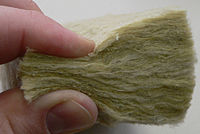
Photo from wikipedia
Abstract During the process of China's rural urbanization and agricultural supply-side reform, the disposal of a large number of agricultural and forestry wastes will be a big problem. This study… Click to show full abstract
Abstract During the process of China's rural urbanization and agricultural supply-side reform, the disposal of a large number of agricultural and forestry wastes will be a big problem. This study deals with effect of four variables on the thermal, mechanical, hydraulic properties and microscopic morphology of the bio-insulation materials using wheat straw as aggregate and geopolymer as binder. The four variables are wheat straw length dimension (L), prewetting water /wheat straw mass ratio1 (Wp/W), wheat straw/solid content of binder mass ratio (W/S) and H2O2/solid content of binder mass ratio (H/S), respectively. The results show that all the four variables have a great influence on the foaming process and skeleton structure of the geopolymer, which greatly affect the properties of the bio-insulation materials. In conclusion, the thermal conductivity of bio-insulation materials varies from 0.092 to 0.186 W m−1 K−1, and the compressive strength varies from 0.18 to 5.622 MPa with the density being 235–894.1 kg m−3. Moreover, the values of water and moisture absorption rates are 32–107% and 4–33% respectively. A desirable bio-insulation material with wheat straw length of 0.2 cm, Wp/W being 1, W/S being 0.124, and H/S being 0.0124, is recommended, of which the thermal conductivity is 0.101 W m−1 K−1 with the compressive strength being 1.2 MPa and the density being 302.4 kg m−3. This new kind of bio-insulation material exhibits good thermal and mechanical performances, which allows it to be applied as a thermal insulation material in buildings, especially the prefabricated buildings. And it is beneficial to energy saving and environmental protection.
Journal Title: Energy and Buildings
Year Published: 2019
Link to full text (if available)
Share on Social Media: Sign Up to like & get
recommendations!